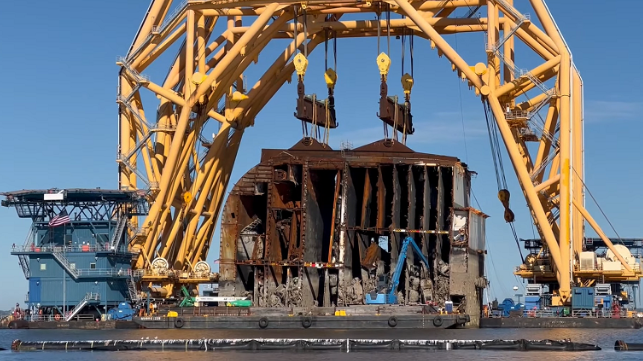Last Section of Golden Ray Removed From St. Simons Sound

The very last section of the wrecked ro/ro Golden Ray has finally departed the site where the vessel went aground in St. Simons Sound, Georgia more than two years ago.
Last weekend - after a careful, multi-day hoisting operation involving multiple pauses for cargo and sediment removal - the heavy lift barge VB 10,000 brought the final section fully out of the water. Salvage engineers made final checks and modifications to a cradle system that would hold the section securely on a dry dock barge for transit to a nearby pier. Once ready, a team of tugboats positioned the dry dock barge underneath the section to receive it. The evolution was successful, and the last chunk of the vessel's hull headed away from the site at last on Monday morning.
The end of the operation follows nearly one year after cutting on the Golden Ray's hull began. The cost of the vessel, her cargo and the highly complex wreck removal process is stacking up towards $1 billion, making it quite possibly the second-most-expensive operation of its kind in history (after the record-shattering Costa Concordia).
The section will now be towed to a local facility for partial dismantling. A heavy-lift barge crane, the Thor, has been mobilized to St. Simons Sound in order to take apart the final two sections piece by piece. These 200-500 tonne chunks will then be floated away to a recycling yard in Louisiana, where they will join the previously removed 4,000-tonne sections of the Golden Ray for scrapping.

that matters most
Get the latest maritime news delivered to your inbox daily.
The Golden Ray went aground and partially capsized in Georgia's St. Simons Sound in September 2019. During an outbound transit in calm conditions, a routine turn to starboard turned into an uncontrolled runaway maneuver, ending with the vessel aground and resting on her side.
Lt. Ian Oviatt, a staff engineer at the Coast Guard Marine Safety Center, told the NTSB that the vessel had taken on too little ballast for her cargo load. “The cause of the vessel capsizing was lack of righting energy due to the way the vessel was loaded,” Oviatt testified before an NTSB panel last September. “The vessel could have taken on additional ballast to be in compliance.” The NTSB's final report on the casualty reached a similar conclusion.
